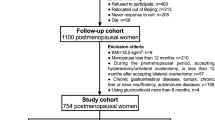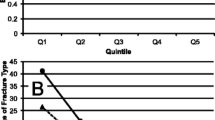Abstract
Summary
Weight and body mass index are associated with low bone mineral density and fractures in older women. This retrospective cohort study confirms a similar relationship in women aged 40 to 59 years.
Introduction
Risk factors for the prediction of osteoporosis and fractures have been less thoroughly studied in younger women. We evaluated the associations between weight, body mass index (BMI), the Osteoporosis Self-Assessment Tool (OST), bone mineral density (BMD) and fracture risk in women aged 40 to 59 years.
Methods
Using administrative health management databases, we conducted a retrospective cohort study in 8,254 women aged 40–59 years who had baseline BMD testing. Linear regression and Cox proportional multivariate models were created to examine the associations with weight, BMI, OST, BMD, and subsequent fractures throughout a 3.3-year follow-up.
Results
Body weight, BMI, and OST had a similar overall performance in their ability to classify women with femoral neck T-score ≤ −2.5. Throughout 27,256 person years of observation, 225 women experienced one or more fractures. After adjustment for age, prevalent fractures, and use of corticosteroids, each standard deviation decrease in weight was associated with a 19% increase in the risk of incident fracture (95% CI: 1.01–1.35). Femoral neck BMD and the presence of prevalent fractures were also associated with the risk of incident fractures.
Conclusions
Low weight and BMI predict osteoporosis and are associated with increased fracture risk in younger women. The negative impact of low body weight on bone health should be more widely recognized.
Similar content being viewed by others
References
Sambrook P, Cooper C (2006) Osteoporosis. Lancet 367:2010–2018
Brown JP, Josse RG (2002) 2002 clinical practice guidelines for the diagnosis and management of osteoporosis in Canada. CMAJ 167:S1–S34
National Osteoporosis Foundation (2003) Physician's guide to the prevention and treatment of osteoporosis. National Osteoporosis Foundation, Washington, DC
Kanis JA (2002) Diagnosis of osteoporosis and assessment of fracture risk. Lancet 359:1929–1936
Cummings SR, Nevitt MC, Browner WS, Stone K, Fox KM, Ensrud KE et al (1995) Risk factors for hip fracture in white women. Study of Osteoporotic Fractures Research Group. N Engl J Med 332:767–73
Van Staa TP, Leufkens HG, Abenhaim L, Zhang B, Cooper C (2000) Use of oral corticosteroids and risk of fractures. J Bone Miner Res 15:993–1000
Kanis JA, Borgstrom F, De Laet C, Johansson H, Johnell O, Jonsson B et al (2005) Assessment of fracture risk. Osteoporos Int 16:581–89
Kanis JA, Oden A, Johnell O, Johansson H, De Laet C, Brown J et al (2007) The use of clinical risk factors enhances the performance of BMD in the prediction of hip and osteoporotic fractures in men and women. Osteoporos Int 18:1033–1046
Reid IR (2002) Relationships among body mass, its components and bone. Bone 31:547–555
Felson DT, Zhang Y, Hannan MT, Anderson JJ (1993) Effects of weight and body mass index on bone mineral density in men and women: the Framingham study. J Bone Miner Res 8:567–573
De Laet C, Kanis JA, Oden A, Johanson H, Johnell O, Delmas P et al (2005) Body mass index as a predictor of fracture risk: a meta-analysis. Osteoporos Int 16:1330–1338
Johnell O, O'Neill T, Felsenberg D, Kanis J, Cooper C, Silman AJ (1997) Anthropometric measurements and vertebral deformities. European Vertebral Osteoporosis Study (EVOS) Group. Am J Epidemiol 146:287–293
Williams AR, Weiss NS, Ure CL, Ballard J, Daling JR (1982) Effect of weight, smoking, and estrogen use on the risk of hip and forearm fractures in postmenopausal women. Obstet Gynecol 60:695–699
Roy DK, O'Neill TW, Finn JD, Lunt M, Silman AJ, Felsenberg D et al (2003) Determinants of incident vertebral fracture in men and women: results from the European Prospective Osteoporosis Study (EPOS). Osteoporos Int 14:19–26
Leslie WD, Metge C (2003) Establishing a regional bone density program: lessons from the Manitoba experience. J Clin Densitom 6:275–282
Leslie WD, Caetano PA, Macwilliam LR, Finlayson GS (2005) Construction and validation of a population-based bone densitometry database. J Clin Densitom 8:25–30
Roos LL, Walld RK, Romano PS, Roberecki S (1996) Short-term mortality after repair of hip fracture. Do Manitoba elderly do worse? Med Care 34:310–326
Roos LL, Mustard CA, Nicol JP, McLerran DF, Malenka DJ, Young TK et al (1993) Registries and administrative data: organization and accuracy. Med Care 31:201–212
Leslie WD (2006) The importance of spectrum bias on bone density monitoring in clinical practice. Bone 39:361–368
Binkley N, Kiebzak GM, Lewiecki EM, Krueger D, Gangnon RE, Miller PD et al (2005) Recalculation of the NHANES database SD improves T-score agreement and reduces osteoporosis prevalence. J Bone Miner Res 20:195–201
Hansen KE, Binkley N, Christian R, Vallarta-Ast N, Krueger D, Drezner MK et al (2005) Interobserver reproducibility of criteria for vertebral body exclusion. J Bone Miner Res 20:501–508
Cadarette SM, Jaglal SB, Murray TM, McIsaac WJ, Joseph L, Brown JP (2001) Evaluation of decision rules for referring women for bone densitometry by dual-energy x-ray absorptiometry. JAMA 286:57–63
Koh LK, Sedrine WB, Torralba TP, Kung A, Fujiwara S, Chan SP et al (2001) A simple tool to identify Asian women at increased risk of osteoporosis. Osteoporos Int 12:699–705
Gourlay ML, Miller WC, Richy F, Garrett JM, Hanson LC, Reginster JY (2005) Performance of osteoporosis risk assessment tools in postmenopausal women aged 45–64 years. Osteoporos Int 16:921–927
Kanis JA, Johnell O, Oden A, Dawson A, De Laet C, Jonsson B (2001) Ten year probabilities of osteoporotic fractures according to BMD and diagnostic thresholds. Osteoporos Int 12:989–995
Leslie WD, Tsang JF, Caetano PA, Lix LM (2007) Effectiveness of bone density measurement for predicting osteoporotic fractures in clinical practice. J Clin Endocrinol Metab 92:77–81
DeLong ER, DeLong DM, Clarke-Pearson DL (1988) Comparing the areas under two or more correlated receiver operating characteristic curves: a nonparametric approach. Biometrics 44:837–845
Hawker GA, Jamal SA, Ridout R, Chase C (2002) A clinical prediction rule to identify premenopausal women with low bone mass. Osteoporos Int 13:400–406
Kanis J, Johnell O, Oden A, Johansson H, Eisman J, Fujiwara S et al. (2006) The use of multiple sites for the diagnosis of osteoporosis. Osteoporos Int 17:527–534
Leslie WD, Lix LM, Tsang JF, Caetano PA (2007) Single-site vs multisite bone density measurement for fracture prediction. Arch Intern Med 167:1641–1647
Rud B, Hilden J, Hyldstrup L, Hrobjartsson A (2007) Performance of the Osteoporosis Self-Assessment Tool in ruling out low bone mineral density in postmenopausal women: a systematic review. Osteoporos Int 18:1177–1187
Gourlay ML, Powers JM, Lui LY, Ensrud KE (2008) Clinical performance of osteoporosis risk assessment tools in women aged 67 years and older. Osteoporos Int doi:10.1007/s00198-007-0555-1
Kanis JA, Johnell O, Oden A, Johansson H, McCloskey E (2008) FRAX and the assessment of fracture probability in men and women from the UK. Osteoporos Int 19:385–397
Kanis JA, Johnell O, De Laet C, Johansson H, Oden A, Delmas P et al (2004) A meta-analysis of previous fracture and subsequent fracture risk. Bone 35:375–382
Pepe MS, Feng Z, Huang Y, Longton G, Prentice R, Thompson IM et al (2008) Integrating the predictiveness of a marker with its performance as a classifier. Am J Epidemiol 167:362–368
Vescovi JD, Jamal SA, De Souza MJ (2008) Strategies to reverse bone loss in women with functional hypothalamic amenorrhea: a systematic review of the literature. Osteoporos Int 19:465–478
Ensrud KE, Cauley J, Lipschutz R, Cummings SR (1997) Weight change and fractures in older women. Study of Osteoporotic Fractures Research Group. Arch Intern Med 157:857–863
Siminoski K, Leslie WD, Frame H, Hodsman A, Josse RG, Khan A et al (2005) Recommendations for bone mineral density reporting in Canada. Can Assoc Radiol J 56:178–188
Acknowledgements
We are indebted to Manitoba Health for providing data. The authors had full access to all of the data in the study and take responsibility for the integrity of the data and the accuracy of the data analysis. The results and conclusions are those of the authors, and no official endorsement by Manitoba Health is intended or should be inferred. This article has been reviewed and approved by the members of the Manitoba Bone Density Program Committee. This study was supported in part by an unrestricted educational grant from the CHAR/GE Healthcare Development Awards Programme.
Conflicts of interest
S. Morin: honoraria for lecture and advisory board membership from Merck Frosst, Procter & Gamble, sanofi-aventis, Novartis, E. Lilly, Servier, and Amgen.
W.D. Leslie: honoraria for lectures in the past year: Merck Frosst Canada.
Unrestricted educational and research grants: Merck Frosst Canada, The Alliance for Better Bone Health - sanofi-aventis and Procter & Gamble Pharmaceuticals Canada, Novartis Pharmaceuticals Canada.
James T. Tsang: No conflicts.
Author information
Authors and Affiliations
Corresponding author
Additional information
On behalf of the Manitoba Bone Density Program.
Rights and permissions
About this article
Cite this article
Morin, S., Tsang, J.F. & Leslie, W.D. Weight and body mass index predict bone mineral density and fractures in women aged 40 to 59 years. Osteoporos Int 20, 363–370 (2009). https://doi.org/10.1007/s00198-008-0688-x
Received:
Accepted:
Published:
Issue Date:
DOI: https://doi.org/10.1007/s00198-008-0688-x




